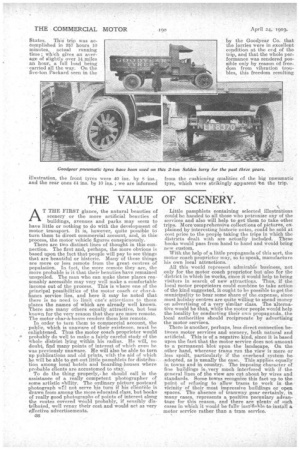THE VALUE OF SCENERY.
Page 14

If you've noticed an error in this article please click here to report it so we can fix it.
A
T THE FIRST glance, the natural beauties of
i
scenery or the more artificial beauties of
.
buildings, avenues and parks may seem to have little or nothing to do with the development of motor transport. It is, however, quite possible to turn them to direct commercial account, and, in this process, the motor vehicle figures conspicuously.
There are two distinct lines of thought in this connection. The first and, perhaps, the more obvious is based upon the fact that people will pay to see things that are beautiful or historic. Many of these things are more or less remote from the great centres of population. In fact, the more remote they are, the more probable is it that their beauties have remained unspoiled. The man who can make these places reaionably accessible may very well make a comfortable income out of the process. This is where one of the principal possibilities of the motor coach or char-abanes service lies, and here it may be noted that there is no need to limit one's attentions to those places the names of which are already well known. There are many others equally attractive, but less .. known for the very reason that they are more remote. The motor char-a-hums renders them less remote.
In order to turn them to commercial account, the public, which is unaware of their existence, must he enlightened. Thua the motor coach proprietor would
A probably do well to make a fairly careful study of the whole district lying , within his radius. He will, no doubt, find many points of interest of which even he was previously unaware. He will also be able to turn up publications and old prints, with the aid of which he will be able to get out little pamphlets for distribu, tion among local hotels and boarding-houses where .probable clients are accustomed to stay. To do the thing properly,. he should call in the assistance of a really competent photographer of some artistic ability. The ordinary picture postcard photograph wrl not serve his turn if his clientele is drawn from among the more educated class, but books of really good photographs of points of interest along the routes covered would probably, if sensibly distributed, well repay their cost and would set as very effective advertisements.
Little pamphlets containing selected illustrations could be handed to all those who patronize any of the aervices and also will help to get them to take other trips. More'comprehensive collections of pictures, ex. planted by interesting historic notes could be sold at. cost price to the people. taking the trips in which the districts dealt with are actually included. These books would pass from hand to hand and Wo'uld bring new custom.
With the help of a little propaganda of this sort, the motor coach proprietor may, so to speak, manufacture his own local attractions.
All this would represent admirable business, not only for the motor coach proprietor but also for the ' district in which he works, since it would help to bring visitors in search of new attractions. Thus, if the local motor proprietors could combine to take action of the kind suggested, it ought to be possible to get the municipality to bear. some share of the expense, since most holiday centres are quite willing to spend money " on advertising of a very similar class. The 'alterna tive would be that, while the motor people would help the locality by conducting their own propaganda. the local authorities should reciprocate by adverasing the motor -services.
There is another, perhaps, less direct connection be
tween motor services and scenery, both natural and. artificial. This is of a negative kind, since it is based upon the fact that the motor service does not amount to a permanent blot upon the landscape. On the other hand, wherever trams run the view is more or less spoilt, particularly if the overhead system be ,adopted, as is usually the case. This. applies equally in towns and in country. The imposing character of fine buildings is very much interfered with if the general lines of the view, are cut about by wires and standards. Some towns recognize this fact up to the point of refusing to allow trams ms to work n the vicinity of their most impressive buildings or open spaces. The absence of tramway gear certainly, . in many cases, represents a positive pecuniary advantage for this reason, and there are plenty of sitch eases in which it would be fully instifiAle to install a motor service rather than a tram service.






















